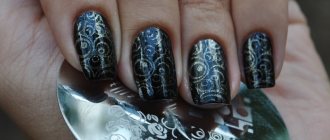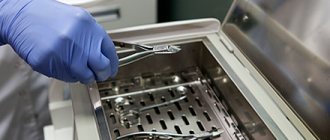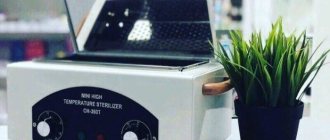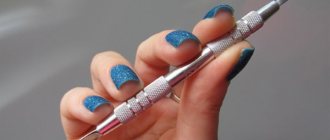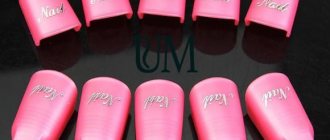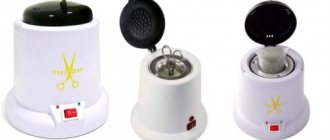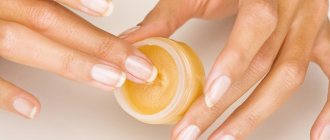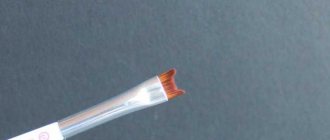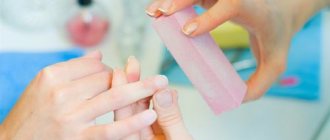Disinfection of manicure instruments involves immersing them in a solution of a product that destroys most pathogens. It is carried out after a single procedure and can last from 5-15 minutes to 1 hour. The time depends on the type of solution and concentrate used.
Alaminol, Optimax, MultiDez, Bianol, Estilodez, which are diluted with water, are well disinfected. Use solutions from 0.5 to 5%. At home, you can disinfect manicure accessories with 70-degree alcohol, but this is unacceptable for salons. After all, they are controlled by SES using disinfection logs and operate in accordance with SanPin 2.1.2.2631-10.
What is disinfection of manicure instruments?
Disinfection of manicure instruments is one of the stages of cleaning them from skin particles and nail dust, as well as pathogens. The procedure is performed for reusable accessories - scissors, nippers, files, hardware cutters. It involves soaking in a disinfectant solution diluted with water for 30-60 minutes.
They use Alaminol, Brilliant, MultiDez, Optimax and other concentrated formulations. The liquid diluted with water is poured into a special container, and the tools in it are placed on a tray. After completing the manipulation, they are washed with water, air dried and sterilized.
The kit should be disinfected after each client, as prescribed by Sanitary Rules 2.1.3.2630-10, 2.1.2.2631-10, 3.5.13780-03, 3.1.1.2341-08. Control in the cabin is carried out using special logs.
At home, you can disinfect your personal kit by keeping it in ethyl alcohol for half an hour, and then in the oven at 200-250 degrees.
How is it different from sterilization?
Disinfection differs from sterilization in that:
- performed manually using liquid solutions, without the use of any equipment;
- eliminates the main groups of harmful microorganisms;
- applies not only to tools, hardware attachments, but also to worktable surfaces, curing lamps, bathtubs, armchairs, couches, other furniture and equipment;
- requires compliance with safety precautions, that is, it is done with gloves, goggles and a mask.
This process precedes sterilization, which destroys all bacteria, viruses, fungi and spores.
Standards according to SanPiN
The rules of procedure according to SanPiN are as follows:
- When disinfecting, solutions that are not harmful to human health must be used, and products of hazard classes 1 and 2 are prohibited;
- the procedure is performed in the absence of clients;
- a special place must be allocated for it;
- method of manipulation - immersion;
- its goal is the destruction of pathogenic microorganisms, and not just delaying their reproduction; disinfection solutions are also selected with this in mind;
- disinfecting liquids must be stored in containers that indicate their names and expiration dates;
- surface treatment of furniture and equipment is performed 2 times a day;
- General cleaning is done weekly, during which walls, floors, baseboards, windows, and doors are wiped with disinfectant solutions;
- oilcloth pillows and hand rests are treated after each client by wiping with a disinfectant solution;
- baths are disinfected in the same mode, but by immersion in a disinfecting liquid;
- hand wipes must be disposable, waterproof and thrown away after each client;
- After use, metal instruments are immersed in a disinfectant liquid without prior rinsing with water;
- the procedure is carried out according to the regimen used for viral hepatitis;
- containers for disinfection must have lids and inscriptions with the name, concentration, purpose;
- hygienic manicure is carried out by a master only wearing gloves;
- Before starting each procedure, he must wash his hands and treat them with an antiseptic.
The requirements are in SanPiN 2.1.2.2631-10, SanPiN 2.1.3.2630-10.
Watch the video about the standards for processing manicure instruments according to SanPiN:
Procedure time
The disinfection time for instruments is 5-60 minutes. This is how long they should be in the disinfecting solution. The duration depends on its type and concentration.
Differences between at home and salon
The procedure at home is easier than in the salon if the manicure is performed only for yourself. It is enough to clean the tools from skin particles and nails with a damp cloth and soak them in 70-degree ethyl alcohol or chloramine for 30 minutes. After time has passed, they are removed from the liquid, washed under running water and dried. Then the manicure devices should be “fried” in the oven at a temperature of 200-250 degrees for an hour.
When the cabinet has cooled down, you can take them out and store them in a sealed container until next use.
In a manicure studio or salon, such cleansing is not enough for the safety of the master and clients, therefore:
- Disinfection is carried out using special solutions. They have a special composition and are diluted in such a way as to ensure an effect on the hepatitis virus and more susceptible microorganisms. The name of the drug and concentration are recorded in the journal. The document can be checked by the SES, it must be stored for 3 years.
- Sterilization is carried out using special equipment that has a certificate. The latter is issued to dry-heat ovens, including those with infrared radiation, autoclaves and glasperlene devices, as they destroy HIV and hepatitis viruses. That is, the devices comply with SanPiN requirements.
Instruments should be stored in craft bags, maintaining sterility until use. If sterilization was done without the latter, you still need a special box for manicure accessories. At the beginning of the working day, at least 3 sets must be clean.
What to buy for a novice master
To disinfect manicure instruments you need to buy:
- a plastic container in which they will be soaked in the solution;
- brushes to wash manicure accessories before drying and sterilizing;
- measuring cup, gloves, masks;
- concentrated means for disinfecting manicure instruments.
You will also need containers with lids for wiping furniture, washing windows, walls and floors (each should be labeled), as well as rags intended for all types of surfaces.
Concentrates
The procedure requires concentrated disinfectant solutions, that is, liquids with a large number of bacteria-killing components. Immediately before each use, they are diluted in a certain proportion with water. Some formulations in diluted form are stored for up to 10-28 days without losing their properties. They require a separate container with a lid.
The list of the best means for disinfecting manicure instruments, according to nail experts, includes:
- Alaminol,
- Estilodez,
- MultiDez,
- Optimax,
- Bianol,
- Clean,
- Diamond.
They are effective against various types of microbes, safe if precautions are taken, do not cause rust on metal accessories, and do not dull sharp blades.
Box or container
A container or box for disinfecting manicure instruments is a box with a lid and an internal grid on which accessories are laid out. It should be:
- made of material that is not exposed to disinfecting liquids;
- with a tight-fitting lid;
- with a working container spacious enough to accommodate all the tools, enough solution can be poured in;
- compact for easy movement.
The last requirement is important for a small studio space, or for craftsmen traveling to your home. A clean box is convenient to use for storing and transporting sterilized instruments.
You can purchase an ultrasonic cleaner - this is the name of the device for disinfecting manicure instruments. In addition to the solution, it uses ultrasound waves to rid the surfaces of adhering epithelium and nail dust.
Disinfection of which manicure instruments is mandatory?
Nail scissors, clippers and many other devices easily carry dangerous infections. These include deadly viruses. Before starting work, each technician is required to undergo training on disinfecting equipment. However, numerous SES checks indicate that for the most part these rules are ignored.
The most common mistakes are the lack of certified means for disinfecting manicure instruments, incorrect processing methods, and a lack of sets of tools (the minimum number of sets is 3).
Most of the equipment on a nail technician’s table requires thorough disinfection.
So, you need to process:
- scissors;
- wire cutters;
- pusher;
- nail brush;
- buff, files for natural and artificial surfaces;
- manicure table, roller, tray;
- LED or UV lamps;
- dots;
- reusable forms for nail extensions, etc.
In addition to disinfecting manicure tools, the master must take care of the cleanliness of his and the client’s hands, as well as the sterility of the room.
First, let's look at the processing of tools in beauty salons.
Disinfection takes place in four successive stages:
- Cleaning from contaminants. After using manicure tools, you need to remove any remaining cream, oils, or skin flakes. This can be done with water, napkins or brushes.
- The next step is to use a disinfectant for manicure tools. It kills harmful viruses, bacteria and fungi.
- Next, all instruments are sterilized in a special apparatus.
- An obligatory part of disinfection is thorough cleaning of the hands of the master and the client with an antiseptic.
After you have rinsed your tools with water, dip them in the disinfectant solution. Below we will consider what is best to use as disinfectants.
Next, wash all the devices again, dry them thoroughly and process them in a sterilizing machine. Be sure to follow the instructions for your device.
When disinfecting your hands, consider the following rules:
- It is better to use spray products;
- free your hands from rings, watches and bracelets, roll up your sleeves;
- the product must be applied in a non-contact manner;
- fold your hands into a boat shape;
- When disinfecting, do not miss areas of skin between the fingers, the backs of the hands, and the nail bed;
- It is better to purchase disinfectants that can restore the fatty film of the skin, otherwise you may experience dry skin.
Read material on the topic: Therapeutic pedicure: advantages and disadvantages of the procedure
Alaminol and disinfection of manicure instruments: pros and cons
Alaminol is most often used to disinfect manicure instruments, since this antiseptic:
- sold in any pharmacy;
- intended, among other things, for use in medical institutions, that is, it is quite safe and reliable;
- effective against bacteria, many viruses and molds;
- does not cause rust on metal;
- The concentrate is stored for up to 2 years, and the finished solution – for up to 10 days.
It also has disadvantages:
- in case of contact with skin, may cause burning and redness;
- The disinfection procedure lasts 60 minutes.
How to breed
Alaminol should be diluted to a 5% concentration. That is, you need to take 50 ml of the product purchased at the pharmacy and add 950 ml of warm water to it. This will result in a large volume that most likely will not be able to be used at one time. Therefore, it is better to take 25 ml of Alaminol and dilute 475 ml of water. The latter must be heated to at least 18 degrees.
The most popular devices for sterilization and disinfection of manicure instruments
Dry heat cabinet
This is the most commonly used device for disinfecting manicure instruments. The cabinet structure is similar to a conventional kitchen oven. The basis of sterilization is heat treatment. Temperature ranges from 180 to 260 °C.
The residence time of manicure tools in a dry-heat cabinet is from 60 to 120 minutes. Despite the visible advantages of this device (reasonable price and spaciousness), it has a number of disadvantages. Firstly, the device requires a lot of energy to operate. In addition, very long heat treatment deforms the tool materials.
Autoclave
The structure of an autoclave is similar to a double boiler. In terms of its properties, this device for disinfecting manicure instruments is clearly a leader compared to a dry-heat oven.
Its main advantages:
- minimum processing time;
- low energy consumption;
- maintaining the quality of the instruments.
All this is achieved thanks to correctly selected parameters: pressure of 3 atm, humidity (distilled water steam) and temperature (134 ° C). The disadvantage of an autoclave is its high cost.
This device is also inconvenient because only distilled water is suitable for its operation. Aggressive chemicals contained in tap water damage appliances and the device itself.
Kraft bags
Before processing in a sterilizer, instruments are placed in craft bags and sealed with paper clips. After disinfection, manicure instruments remain sterile for another three days. Sealed Kraft bags remain clean for longer – 20 days, and heat-sealed bags – 30.
Glasperlene sterilizer
The advantages of a glasperlene (“ball”) sterilizer are compactness, low price and incredibly high disinfection speed – 15–180 seconds.
However, this device has a number of disadvantages:
- The disinfection process involves dipping manicure tools into quartz. Due to interaction with this material, highly abrasive files become dull over time.
- The balls require fairly frequent replacement (once every six months to a year), since over time quartz loses its heat-conducting properties.
- A significant disadvantage of the glasperlene preparation is that it only treats the working part of the instruments. The handle is not disinfected.
The FDA does not recommend using quartz beads to disinfect manicure instruments.
UV and ultrasound
Sometimes such devices are also classified as sterilizers. However, they have a slightly different purpose: an ultrasonic device is usually used to prepare manicure instruments, and an ultraviolet device is used for storage after the disinfection procedure.
Recommended articles on this topic:
- Where to buy nail files
- How to choose a manicure set for a beginner master
- Professional pedicure files
Other solutions for disinfecting manicure instruments
A solution for disinfecting manicure instruments can be chosen from several:
- MultiDez,
- Estilodez,
- Diamond,
- Bianol,
- Clean.
These are compositions based on surfactants or quaternary ammonium compounds. All are effective against microorganisms at the first stage of cleaning, consisting of disinfection, PSO, and sterilization of manicure instruments. Using concentrates, you can also perform a pre-sterilization procedure by adding less water when diluting. For example, to combine disinfection and PSO with MultiDez, you need a 4% solution, not a 2% solution.
MultiDez
Disinfection of manicure instruments with MultiDes is also popular among nail professionals, as the product:
- has a hazard class 4, that is, it does not threaten people and animals when used correctly;
- copes with several types of bacteria, viruses and fungi;
- does not spoil manicure accessories;
- is consumed little by little;
- has an affordable price - 700-900 rubles. for 1 l;
- the finished solution is stored for up to 28 days, and the concentrate remains valid for 5 years after the date of manufacture.
To dilute MultiDez to disinfect manicure instruments, you need to take 10 ml of this product and 400 ml of water. You will obtain a 2% solution in which the instruments should be soaked for 15 minutes. During this time, it is possible to get rid of 80% of microorganisms.
When making a solution, first pour the concentrate into the container, then the second component, otherwise there will be a lot of foam. After all, MultiDez contains several surfactants.
Estilodez
Estilodez for disinfecting manicure instruments can be prepared in several versions:
- 0.5% for keeping for 1 hour (dilute 5 ml of product in 995 ml of water);
- 1% is made per 30 minutes (10 ml of concentrate and 990 ml of water);
- 2% - for a 5-minute manipulation (20 ml of product per 980 ml of water).
To prepare the solution, the concentrate is first added to the container, then water. The effectiveness and safety of Estilodez are comparable to the same indicators of MultiDez. It can also be used for ultrasonic cleaning, since it contains a surfactant. The cost of the concentrate is 720-950 rubles. for 1 l.
Diamond
The Diamond product also has three types of activity, that is, it destroys bacteria, several types of viruses and fungus. It is pH neutral, so it will not cause rust on instruments. The composition contains detergent components, so Diamond cleanses manicure accessories well from particles of epithelium and nail dust.
The concentrate is mixed with water at a temperature of 20-50 degrees above zero. It is weaker than previous products, so it should be diluted to 4%. That is, take 40 ml of Diamond per 996 ml of water. Instruments must be immersed in the solution for 15 minutes. A liter canister can be bought for 500-600 rubles.
Bianol
Bianol is a transparent blue liquid, which consists of glutaraldehyde, alkydimethylbenzylammonium chloride, glyoxal and excipients. For disinfection, use a 2% solution. It is prepared from 20 ml of concentrate and 980 ml of water. The first component should be mixed before dilution. The disinfection procedure should last 15-20 minutes.
The solution destroys many types of bacteria, viral pathogens, and fungi. It does not corrode the skin upon contact with it and has almost no odor. But it can be stored for no longer than 10 days, and the concentrate can be used within 1 year from the date of release. The cost of Bianol is 400-500 rubles. per liter
Clean
Chistodez contains a complex of CHAS, PGMG, surfactants, and anti-corrosion components, that is, it works a little differently than previous products. It affects gram-negative and gram-positive bacteria, almost all known viruses, and fungi. The following solutions are used for disinfection:
- 0.5%. Prepared from 5 ml of concentrate and 995 ml of water. The procedure should last 1 hour.
- 1%. To prepare, take 10 ml of product and 990 ml of water. Soaking time for manicure accessories is 30 minutes.
- 2%. The solution is made from 20 ml of concentrate and 980 ml of water. It is enough to hold the tools in it for 5 minutes.
The cost of the product is from 500 rubles. and above for 1 liter.
Alcohol
Professionals do not use alcohol to disinfect manicure instruments because:
- it is ineffective against spores and useless against some bacteria;
- the liquid ceases its effect immediately after evaporation from the surfaces being treated, and this happens quickly;
- its properties deteriorate upon contact with mucus and proteins, which is difficult to avoid when processing scissors, files, pushers, etc.
You can wipe personal manicure accessories with a 70-degree liquid using a cotton pad generously soaked in it.
Disinfection of manicure instruments at home
There are fewer rules for disinfecting manicure instruments at home than in a salon, but you should not neglect them. Devices for home manicure are treated with ethyl alcohol or chloramide. You will also need sterile gauze or wipes.
Stage 1. First, prepare all the manicure tools that you want to process.
Step 2: Remove dirt.
Step 3. Next, pour ethyl alcohol into a small container. Put your tools in there.
Step 4. After half an hour, remove the devices and rinse them in running water.
Stage 5. After complete drying, place the tools in an oven heated to +200...+250 °C. Then turn off the oven and wait for your appliances to cool.
Drying in the oven is still unable to destroy all viruses and infections. Therefore, this type of disinfection is only suitable for home manicure instruments that have only one owner. If you work as a nail technician at home, you need to purchase a sterilizer.
When disinfecting manicure instruments at home, follow these rules:
- When drying in the oven, you need to leave a small distance between the tools.
- After drying, you should wait until the devices have cooled down. This will help avoid burns.
- There is no need to speed up the cooling of the devices (immerse them in cold water, etc.). It's better to let them cool down on their own.
- When purchasing sterilizers and antiseptics, pay attention to the quality of the samples. After all, you care about your safety and that of your visitors!
If you conscientiously follow all disinfection requirements, your instruments will retain their quality longer.
Previously, boiling was mainly used to disinfect manicure instruments. The advantage of this method is that exposure to high temperatures destroys harmful viruses and infections. However, many materials begin to deteriorate with frequent and long heat treatments. But if you don't have an oven nearby, use boiling.
Bring the water to a boil and lower the appliances into it. They should remain in boiling water for about 15 minutes. Using sterile forceps, remove the instruments and place them on a paper towel. After drying, place the treated devices in craft bags.
It is better to use UV sterilizers for storing devices. They are equipped with special bactericidal lamps.
Disinfection of manicure instruments is the basis of the entire disinfection process. These rules are mandatory for home and salon nail artists. You should not ignore the treatment of devices when doing your own manicure. Thorough sterilization is the key to the safety and good attitude of visitors.
Read material on the topic: Which nail file is better - a review of the most suitable options
Proper disinfection and sterilization of manicure instruments: stages
Proper disinfection and sterilization of manicure instruments consists of several stages:
- Prepare a solution in a container with a lid and stir.
- It is poured into the box where the instruments will be processed.
- They are placed in the liquid in an open form; it should cover the metal parts by a little more than 2 cm.
- Maintain the time required for processing.
- The instruments are removed and washed for several minutes under running water using a brush (this is the 1st stage of PSO).
- For some time, manicure accessories should be left in distilled water (2nd stage of PSO).
- Then they are removed and laid out on a napkin to dry until the liquid has completely evaporated.
- The next step is sterilization in a dry heater or glasperlene, infrared apparatus or autoclave for a certain time.
- Fully processed instruments are stored in a special box.
All manipulations are done with gloved hands, and there should be a mask on the face. After the sterilizer, instruments may be hot, so tweezers or forceps are needed to remove them. If a dry heat is used, after the 7th stage each tool is sealed in a craft bag. This way they are sterilized and then stored. And they print the package in the presence of the client.
Watch the video about disinfection and sterilization of manicure instruments:
Chemical sterilization of manicure instruments
Chemical sterilization - as an alternative method for processing manicure instruments
Sometimes a method such as chemical sterilization comes up in conversations. Yes, this kind of thing does exist and is completely permitted. But how suitable it is for us, nail artists - let's figure it out. Let's go.. Chemical sterilization is regulated by clause 4.6 of the “Methodological Instructions for Disinfection, Pre-sterilization Cleaning and Sterilization of Medical Products” MU-287-113. Let's go straight point by point.
Features of chemical sterilization of manicure instruments
Clause 4.6.1 - chemical sterilization is an auxiliary method, since products cannot be sterilized in packaging, and upon completion of sterilization they must be washed with a sterile liquid (drinking water, 0.9% sodium chloride solution), which, if aseptic rules are violated, can lead to secondary contamination sterilized products by microorganisms. This method should be used to sterilize products in cases where the characteristics of the product materials do not allow the use of other officially recommended sterilization methods.
Clause 4.6.2. – For sterilization with chemical solutions, use the products indicated in the table. 4.4, - in general, we read table 4.4 in the document and select those means that allow sterilization.
Clause 4.6.3 – When chemically sterilizing products, use sterile containers made of glass, metal, heat-resistant plastics that can withstand steam sterilization, or coated with enamel (enamel without damage).
Clause 4.6.4. – The temperature of the solutions must be at least 18-20 °C. For some, for example Gigasept, it is exactly 21 degrees.
Clause 4.6.5. – 4.6.8. – Sterilization is carried out by completely immersing the products in the solution, laying them out freely. To avoid dilution of working solutions used for sterilization, products immersed in them must be dry. After sterilization, all manipulations are carried out strictly observing the rules of asepsis. The products are removed from the solution using sterile tweezers (forceps), and then washed in a sterile liquid poured into sterile containers. Washed sterile products are used immediately for their intended purpose or placed (using sterile tweezers, forceps) for storage in a sterile sterilization box lined with a sterile sheet for a period of no more than 3 days.
Conclusions. Chemical sterilization as an auxiliary processing method has its place; no one has canceled or banned it. But there are certain conditions that must be met. That is, we sterilize in a sterile container, then rinse again in a sterile container with a sterile liquid. We carry out all manipulations with sterile tweezers. Cover with a sterile napkin. In my opinion, it is very labor-intensive, but if there are no other options, then at least you already know how to do it all. In my opinion, the easiest way to carry out sterilization in a salon is by air method in a dry heater. How to do this - read the article - air sterilization.
Manicure instruments disinfection log: where to get it, how to fill it out
In a salon or studio, an officially working master must have a log of disinfection of manicure instruments, or rather quality control of solutions, which indicates:
- dates of filling and preparation of the mixture;
- its purpose (disinfection) and name;
- volume of prepared substance;
- its concentration (required by SanPiN and real);
- method of analyzing a solution to determine the indicator from the previous paragraph (equipment or test strips);
- data from the person who carried out the analysis.
The control organization monitors the cleanliness of cutters, scissors, files, and wire cutters using a document regarding the receipt and expenditure of disinfectants. To fill out this type of journal for the disinfection of manicure instruments, you must indicate:
- in the first table - the name of the concentrate, date of purchase, quantity, expiration date, name of the person who purchased it;
- in the second - the date, the object of disinfection (instruments), the name of the product and its concentration, the amount used, the name of the person responsible for the procedure.
You can buy both magazines in many online stores. Some people download them online and print them out. The pages in both cases must be bound and numbered. All information is entered by hand.
How often should manicure instruments be disinfected?
Based on the material used, manicure tools can be divided into two categories: porous and non-porous. The first ones are disposable. If they are used more than once, they require special disinfection. Non-porous instruments are designed to be reused. They are easy to clean from dirt and bacteria.
Different technologies and cleaning agents are suitable for disinfecting manicure instruments of porous and non-porous structures. Therefore, the first step is to determine what type of equipment you have.
- Porous manicure tools include fabric, wood and absorbent ones: nail files, sponges, cotton swabs and orange swabs, paper napkins and towels, and polishing buffs. All of them can only be used once. However, some paper nail files are quite suitable for reusable use. But here you should be careful and observe how they react to disinfection. If the material breaks down, it is better to throw away the nail file.
Cloth towels should be washed every day (after completing work with clients). The use of powder is mandatory.
- Non-porous manicure tools include those made of metal, plastic, glass or fiberglass. These can be manicure cutters, tongs, scissors, brushes. All equipment must be thoroughly cleaned after each visitor. Rules for disinfecting these manicure tools can be found above.
- Attributes that do not come into contact with the skin do not pose a threat of harmful viruses or infections. These include regular varnishes, gel varnishes, acrylics and other similar compositions. All of them do not need disinfection.
Read the material on the topic: How to open a manicure salon: step-by-step instructions
Is it better to buy disposable files?
Disposable files are not disinfected, but are disposed of after a single use, that is, their presence relieves the master of some of the hassle and saves time. Therefore, with a large number of clients, many “manicure fairies” prefer to make do with them. These tools cost 3-9 rubles. for 50 pieces when purchasing in large quantities at once.
For regular clients, if there are few of them, it is better to have a set of reusable tools. Each one must be in a special package, which must be signed. But using files for only one client does not eliminate the need to process them.
Disinfection of manicure accessories is an important part of a nail technician’s work, but it is also important during home procedures. After all, with nails damaged by fungus or injury or infected skin, there can be no question of performing a design. Therefore, when buying tools, gel polishes, brushes, you should take care of purchasing disinfectant solutions, containers, and sterilizer.
